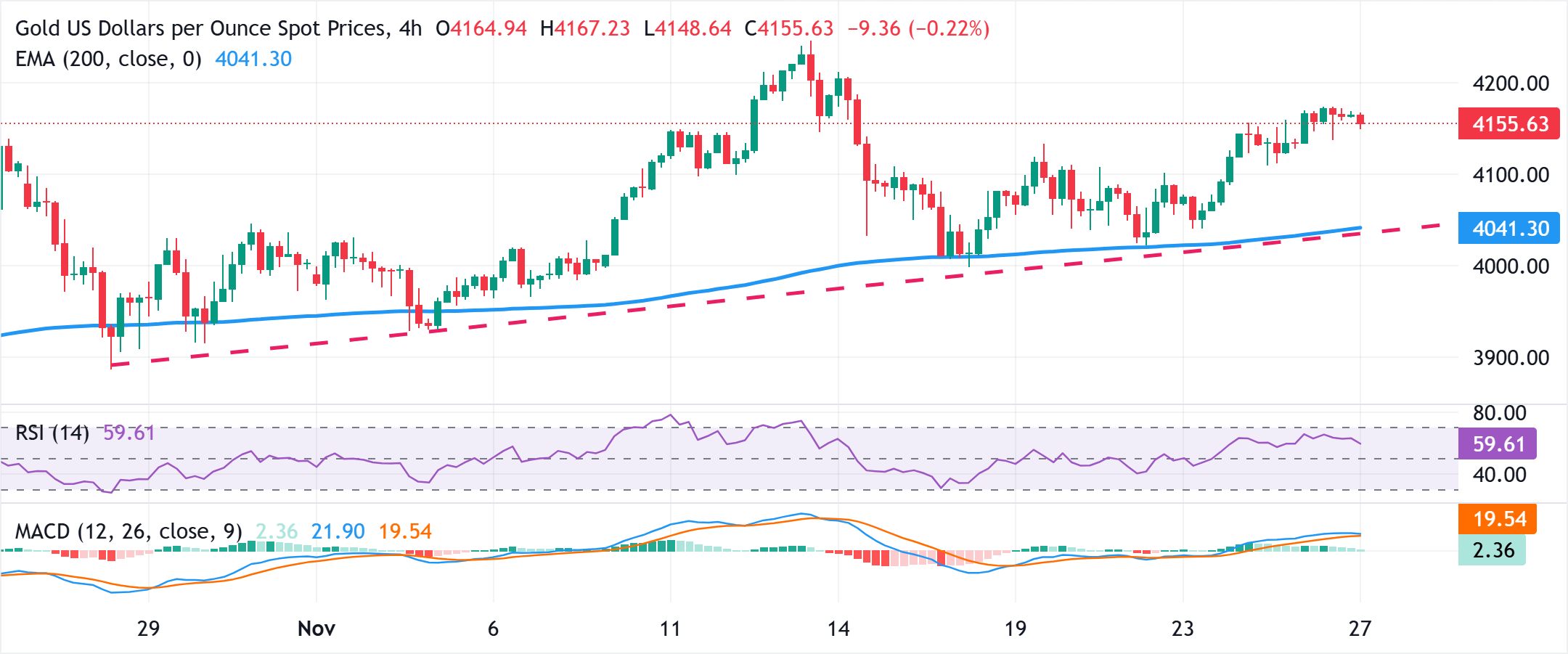Gold eases from two-week top amid risk-on mood; downside seems limited

- Gold edges lower on Thursday as the upbeat market mood prompts some profit-taking.
- The risk-on mood and hopes for a Russia-Ukraine peace deal undermine the commodity.
- Dovish Fed expectations keep the USD depressed and could support the precious metal.
Gold (XAU/USD) attracts some sellers during the Asian session on Thursday and erodes a part of the previous day's gains to a nearly two-week top. The prospects for lower US interest rates, along with hopes for a peace deal between Russia and Ukraine, remain supportive of the upbeat market mood. This, in turn, is seen driving some flows away from the safe-haven bullion amid relatively thin trading volumes on the back of the Thanksgiving holiday in the US.
Meanwhile, a mixed set of US economic indicators released this week did little to alter market expectations that the US Federal Reserve (Fed) will cut interest rates again at its December policy meeting. The outlook drags the US Dollar (USD) to over a one-week low and should continue to act as a tailwind for the non-yielding Gold. This, in turn, suggests that any meaningful corrective decline might still be seen as a buying opportunity and is more likely to remain cushioned.
Daily Digest Market Movers: Gold bulls turn cautious amid receding safe-haven demand
- The US Census Bureau reported on Wednesday that new orders for manufactured Durable Goods Orders rose 0.5% in September, down from the upwardly revised 3.0% increase in the previous month. The reading, however, exceeded market expectations of 0.3%. Additional details of the report showed that new orders excluding transportation rose 0.6% during the reported month, while excluding defense, they increased 0.1% following a 1.9% rise the prior month.
- Separately, the latest figures published by the US Department of Labor showed that the number of Americans filing new applications for unemployment benefits fell to 216K, or a seven-month low, in the week ending November 22. This helps to offset the disappointing release of the Chicago PMI, which unexpectedly fell deeper into contraction territory and came in at 36.3 for November. The US Dollar, however, struggles to lure buyers amid dovish Federal Reserve expectations.
- Recent comments from top Fed officials shifted market expectations strongly in favor of another quarter-point reduction at the December 9-10 FOMC meeting. In fact, New York Fed President John Williams said last Friday that interest rates could fall in the near term without putting the central bank's inflation goal at risk. Moreover, Fed Governor Christopher Waller said at the start of this week that the job market is weak enough to warrant another quarter-point rate cut in December.
- Meanwhile, Fed Governor Stephen Miran echoed the dovish view and noted in a television interview on Tuesday that a deteriorating job market and the economy call for large interest rate cuts to get monetary policy to neutral. The outlook, in turn, drags the USD Index (DXY), which tracks the Greenback against a basket of currencies, to an over one-week low during the Asian session on Thursday. This might continue to act as a tailwind for the non-yielding Gold.
- Russia said that the US-brokered talks to end the war with Ukraine are serious, though Kremlin spokesman Dmitry Peskov cautioned that an agreement is a long way off and Moscow would offer no major concessions. US President Donald Trump said that a Ukraine–Russia agreement is very close, fueling optimism. This, along with prospects for lower US interest rates, remains supportive of a generally positive tone around the equity markets and weighs on the safe-haven bullion.
Gold constructive setup backs the case for the emergence of dip-buyers at lower levels

Any subsequent slide is likely to find decent support near the $4,132-4,130 region, below which the Gold price could accelerate the fall toward the $4,100 mark. Some follow-through selling would expose a confluence support, comprising the 200-period Exponential Moving Average (EMA) on the 4-hour chart and an ascending trend-line extending from late October, currently pegged around the $4,040 area. A convincing break below the latter might shift the near-term bias in favor of bearish traders and drag the XAU/USD pair to the $4,000 psychological mark.
On the flip side, the $4,171-4,173 zone, or a nearly two-week high touched on Wednesday, now seems to act as an immediate hurdle, above which the Gold price could aim to reclaim the $4,200 round figure. A sustained strength beyond the latter will set the stage for an extension of the momentum toward testing the monthly swing high, around the $4,245 zone.
Gold FAQs
Gold has played a key role in human’s history as it has been widely used as a store of value and medium of exchange. Currently, apart from its shine and usage for jewelry, the precious metal is widely seen as a safe-haven asset, meaning that it is considered a good investment during turbulent times. Gold is also widely seen as a hedge against inflation and against depreciating currencies as it doesn’t rely on any specific issuer or government.
Central banks are the biggest Gold holders. In their aim to support their currencies in turbulent times, central banks tend to diversify their reserves and buy Gold to improve the perceived strength of the economy and the currency. High Gold reserves can be a source of trust for a country’s solvency. Central banks added 1,136 tonnes of Gold worth around $70 billion to their reserves in 2022, according to data from the World Gold Council. This is the highest yearly purchase since records began. Central banks from emerging economies such as China, India and Turkey are quickly increasing their Gold reserves.
Gold has an inverse correlation with the US Dollar and US Treasuries, which are both major reserve and safe-haven assets. When the Dollar depreciates, Gold tends to rise, enabling investors and central banks to diversify their assets in turbulent times. Gold is also inversely correlated with risk assets. A rally in the stock market tends to weaken Gold price, while sell-offs in riskier markets tend to favor the precious metal.
The price can move due to a wide range of factors. Geopolitical instability or fears of a deep recession can quickly make Gold price escalate due to its safe-haven status. As a yield-less asset, Gold tends to rise with lower interest rates, while higher cost of money usually weighs down on the yellow metal. Still, most moves depend on how the US Dollar (USD) behaves as the asset is priced in dollars (XAU/USD). A strong Dollar tends to keep the price of Gold controlled, whereas a weaker Dollar is likely to push Gold prices up.







